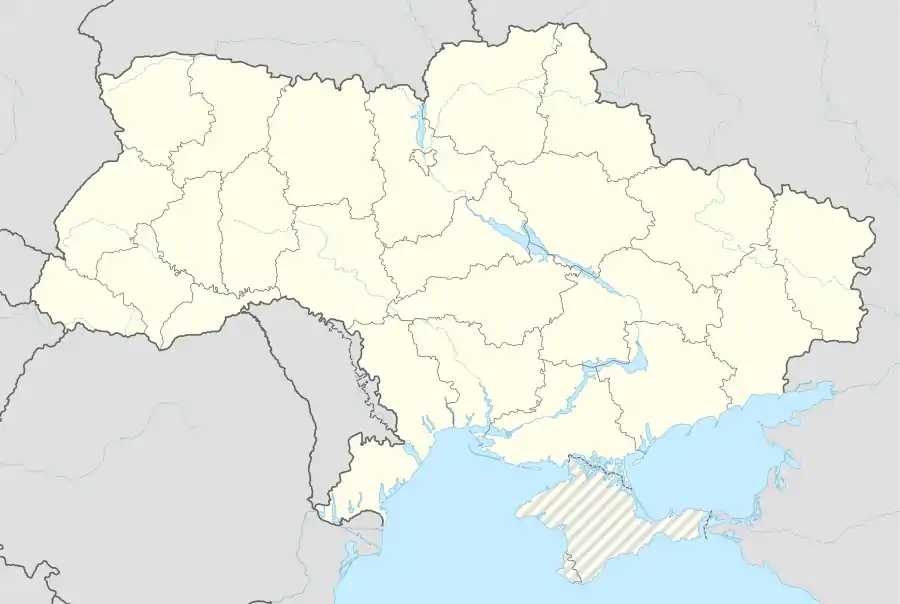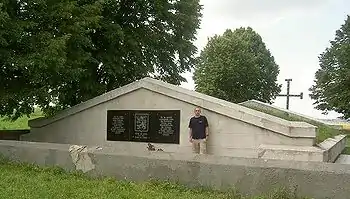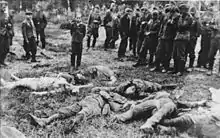Zboriv
Zboriv (Ukrainian: Зборів, Polish: Zborów, Russian: Зборов) is a town in Ternopil Oblast, west Ukraine. It is located in the historical region of Galicia. It is administrative center of the Zboriv Raion. Local government is administered by Zboriv town council.[1] Population: 6,669 (2020 est.)[2]
Zboriv
Зборів Zborów • Зборов | |
|---|---|
 City hall | |
 Flag  Seal | |
 Zboriv Location of Zboriv in Ukraine  Zboriv Zboriv (Ukraine) | |
| Coordinates: 49°40′N 25°09′E | |
| Country | |
| Oblast | |
| Raion | Zboriv |
| First mentioned | 1166 |
| Population (2020) | |
| • Total | 6,669 |
| Time zone | UTC+2 (EET) |
| • Summer (DST) | UTC+3 (EEST) |
The town (located 35 km (22 mi) northwest of Ternopil, and 85 km (53 mi) southeast of Lviv) lies on Strypa River (Ukrainian: Cтpипа).
History
It was mentioned for the first time in a document from 1166. In 1241, during the Mongol invasion of Europe, it was ransacked and destroyed. In 1639, Zboriv was granted city rights. Its present name comes from a noble Polish family of Zborowscy. Ten years later, Zboriv was besieged by the Tartar-Cossack armies during the Khmelnytsky Uprising.
In 1913, Zboriv had about 6000 inhabitants, including 2400 Ukrainians, 1300 Poles and 2300 Jews. During World War I, the town's vicinity was the site of heavy fighting between the Czechoslovak legionnaires and the Austrian Army (June 1917, Battle of Zborov). After the Polish-Ukrainian war 1918-1919, it became part of Poland and was the seat of a powiat of the Tarnopol Voivodeship.


In 1941, during World War II, Zboriv was the site of mass murder conducted by Germans of the Einsatzgruppen, along with local Ukrainians. Information about the Jewish community destroyed during the Holocaust can be found in a Yizkor book published by Jews who fled Zborow and survived the Holocaust.
The town was completely destroyed in the summer of 1944 due to the Soviet offensive. Under Soviet rule (1944–1991), Zboriv was rebuilt and redeveloped. Construction plant and a small food processing factory were built in the 1960s. A significant part of a local budget was relied on agriculture and governmental subsidies. The state farm in Zboriv was one of the best in the region. In the 1980s, the town became the object of serious governmental investments. Among these few new town improvements were built, like: cinema, agricultural market, new secondary school, waterbike lake station, football stadium, a city hall and a culture hall.
After the collapse of the Soviet Union, the local economy experienced a deep downturn. During the 1990s (until present time) as a result of economic decline many working-age people emigrated - mostly as a low-skilled labourers in Western Europe or Russia. Nowadays, in spite of the unfavorable conditions, the younger generation is less likely to quit and prefer to commute daily to work in the larger cities Ternopil and Lviv, which offer wider job opportunities.
Gallery
 Zboriv Orthodox church
Zboriv Orthodox church Catholic church
Catholic church College in Zboriv
College in Zboriv Bohdan Khmelnytskyi monument
Bohdan Khmelnytskyi monument Polish-Soviet War monument
Polish-Soviet War monument
See also
References
- Zborivska city council
- "Чисельність наявного населення України (Actual population of Ukraine)" (PDF) (in Ukrainian). State Statistics Service of Ukraine. Retrieved 30 September 2020.